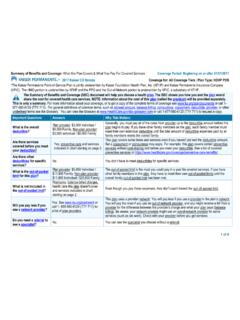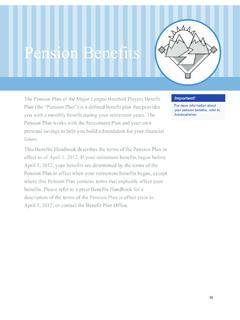Transcription of Your Retirement Benefits - cache.hacontent.com
1 2012 Procter & Gamble, All Rights Reserved Publication Date: 05/31/2012 your Retirement Benefits The Procter & Gamble Profit Sharing Trust and Employee Stock Ownership Plan Plan Information Summary Plan Description and Prospectus July 1, 2007 Summary Plan Description and Prospectus This document constitutes part of a prospectus covering securities that have been registered under the Securities Act of 1933 and should be retained for future reference. The Profit Sharing Trust and Employee Stock Ownership Plan is governed by official Plan documents, which are always the final authority on the Plan. 2012 Procter & Gamble, All Rights Reserved Publication Date: 05/31/2012 Page 2 of 92 Introduction P&G originated on the banks of the Ohio River in Cincinnati, Ohio, when two brothers-in-law merged their specialties into a partnership.
2 William Procter was a candle maker, and James Gamble was a soap maker. The idea of sharing the Company s profits with employees was introduced by a grandson of one of the founders, William Cooper Procter. Cooper, as he was known, had begun his training by working in the factory. Creating an Incentive for Workers After listening to the workers, he wanted to find a way to instill in employees the same desire to succeed as a person who owned their own business. We should let the employees share in the firm s earnings, he said. That will give them an incentive to increase earnings. Cooper Procter introduced the idea of profit sharing to the in 1887. Each employee received a cash payment from the profits of the Company based upon a formula that also considered length of service. The payments were made at a Company picnic on a day known as Dividend Day (a day that many locations in the continue to celebrate).
3 Making Employees Owners of the Company The partnership became a public corporation in 1890. That change eventually prompted another idea from Cooper Procter, then General Manager of the Company. Cooper noticed the cash profit sharing dividends were not being saved for Retirement as he had hoped. This problem led to Cooper introducing in 1903 another unique idea: actually making employees owners of the Company through the award of shares of Company stock. Cooper Procter reasoned that as employees became stock owners, their economic interests and those of the Company would be bound more closely together. This incentive would act to increase profits, which in turn, would increase the price of P&G stock, as well as the dividends each share paid. Both employees and the Company would benefit from an employee stock ownership plan. Profit Sharing and Employee Stock Ownership A Way of Life at P&G At P&G, profit sharing and employee stock ownership are a way of life.
4 Employee ownership has proven to be a vehicle for expanded business success. An employee summed it up once by saying: The pride that comes with being part-owner of the Company makes you think more about the quality of your work. It s like a chain reaction the better the quality, the greater Procter & Gamble s profits and your profits and then you have even more incentive to keep the quality of your work high. The Procter & Gamble Profit Sharing Trust and Employee Stock Ownership Plan (PST Plan) is an employee stock ownership plan (ESOP). The Plan is designed to invest primarily in Company Stock and is intended to meet the applicable requirements of Sections 401(a), 409, and 4975(e)(7) of the Internal Revenue Code. The PST Plan has been providing Benefits to generations of P&G employees in the US. The Plan has gone through many improvements since introduced 124 years ago.
5 Most changes to the Plan over the years have been about giving participants more flexibility. 2012 Procter & Gamble, All Rights Reserved Publication Date: 05/31/2012 Page 3 of 92 Summary Plan Description (SPD) This Summary Plan Description (SPD) was designed to help you better understand your Plan and the flexibility you have under the Plan. It is intended to provide participants with general information about their rights and obligations under the Plan. A complete description of The Procter & Gamble Profit Sharing Trust and Employee Stock Ownership Plan (PST Plan) is contained in the legal plan document and the amendments and supplements to it. This booklet attempts to clearly and accurately summarize the provisions in the PST Plan Document. If there is any disagreement between this booklet and the PST Plan Document, however, the Plan Document governs.
6 Summary of Material Modifications Any Plan changes affecting current participants are communicated to participants through a "Summary of Material Modifications" document which provides a brief summary of any changes to the Plan. The Procter & Gamble Company, acting through its Board of Directors reserves the right to alter or amend the PST Plan. If the Board of Directors alters or amends the Plan, it is through formal action either at a Board of Directors meeting or by written consent pursuant to state law. The Trustees of the Plan have the right to make changes to the investment offerings, which is done through a formal review, recommendation and approval process. 2012 Procter & Gamble, All Rights Reserved Publication Date: 05/31/2012 Page 4 of 92 Table of Contents Introduction 2 Table of Contents 4 Plan Features Summarized 7 Prospectus 8 Plan Participation 9 Eligibility 9 Enrollment 9 Waiver of Participation 10 Naming your Beneficiary 11 your Account 12 How your Account Is Valued 12 How your Account Can Grow 12 Accessing your Account 13 your Account Statement 14 your Account Administration Fee 14 Changing your Account Address 16 your P&G Service 17 Years of Service 17 Plan Credit Years 17 Leaves of Absence 18 Maternity Leave 18 Military Leave 19 Less Than Fulltime and Reduced Work Schedules 20 If You Are an Employee of an Acquired Company 20 If You Are Rehired 20 Rehires/Interns/Co-ops 21 If You Transfer (Localize)
7 Into the United States 21 If You Transfer to a Non-Participating Subsidiary or You Withdraw from the Plan 22 Contributions to your Account 23 Company Contributions 23 Government Limits on Contributions 27 How your Credit from the Annual Company Contribution Is Made 27 The Two Trusts 27 Employee Contributions 29 Vesting 30 Investing your Account 31 Important Details About Making Investment Changes 32 your Investment Choices 34 Fund Performance Summary and Benchmarks 35 Investment Transfer Restrictions 36 Changing your Investments 38 Withdrawals While You Are Employed 39 2012 Procter & Gamble, All Rights Reserved Publication Date: 05/31/2012 Page 5 of 92 P&G Stock Dividend Payment Option 39 Loans 41 In-Service Withdrawals 47 Divorce and Other Claims Against your Account 48 Retirement Age 52 Distributions From your Account 53 If You Are Disabled 53 If You Retire or Leave P&G 54 Retirement Plus 54 Distribution Options if you Retire or Leave P&G 57 Points to Consider Before Choosing a Distribution Option 61 Qualified Joint & Survivor Annuity (QJSA)
8 64 Required Spousal Consent for Distributions other than QJSA 64 If You Die 65 Tax Considerations 67 Federal Income Tax 67 Early Distribution Penalty Tax 68 Rules for Spousal Beneficiaries, Alternate Payees and Other Beneficiaries 68 Special Lump-Sum Tax Rule 69 Taxes on Loans 69 Estate Tax 69 Applying for Benefits 70 Filing for Benefits 70 Making a Claim 70 Appealing a Denied Claim 70 Situations Affecting your Benefits 72 If the Plan Becomes Top-Heavy 72 Corporate Takeover Provisions 72 No Assignment of Benefits 72 If You Are Unable to Care for Yourself 72 No Implied Promises 72 Future of Plans 72 Pension Benefit Guaranty Corporation (PBGC) 72 Retiree Healthcare Fund 73 Administrative Information 76 Plan Identification 76 Plan Trustees and Policy Committee 77 Agent for Service of Legal Process 77 Official Plan Documents 77 Other Documents 78 Plan Funding 79 Limitations on Plan Benefits 79 Securities of the Company 79 your Rights Under ERISA 82 2012 Procter & Gamble, All Rights Reserved Publication Date: 05/31/2012 Page 6 of 92 Notice of Privacy Policy and Practices 84 Financial Education Programs and Tools 86 Contacts 87 Glossary 90 Note to User: Any words that are italicized, such as Morgan Retirement Plan Services, will be found in the back of this document under Contacts.
9 Any words that are underlined will be found in the back of this document under Glossary. 2012 Procter & Gamble, All Rights Reserved Publication Date: 05/31/2012 Page 7 of 92 Plan Features Summarized The Procter & Gamble Profit Sharing Trust and Employee Stock Ownership Plan (Plan or PST Plan) is designed to make you an owner in the Company and to help you accumulate assets for Retirement . Here's how the Plan works: Each year P&G makes a contribution to the Plan. your share of that annual Company contribution is determined based on your eligibility, your base pay, and your length of service. Currently, the annual Company contribution can be made up from two sources - convertible Preferred shares of P&G stock and cash. The cash part of your share of the Company contribution to your PST account is used to buy P&G Common Stock.
10 The Company then pays dividends on its stock, and each share of P&G stock in your PST account earns dividends. The P&G stock dividends are automatically reinvested in more shares of P&G stock within your account. However, because the Plan is an Employee Stock Ownership Plan, you have the ability to choose to have the P&G stock dividends paid out of your account to you as additional cash income each quarter. You can receive payment of your vested PST account when you retire, become disabled or stop working for P&G. When you die, your beneficiary will receive payment of the unpaid value of your account. Spousal beneficiaries have the option to leave their benefit in the Plan and participate in the Retirement Plus feature. At Retirement or separation from employment, you will automatically participate in Retirement Plus if the vested portion of your PST account is at least $1,000.


















